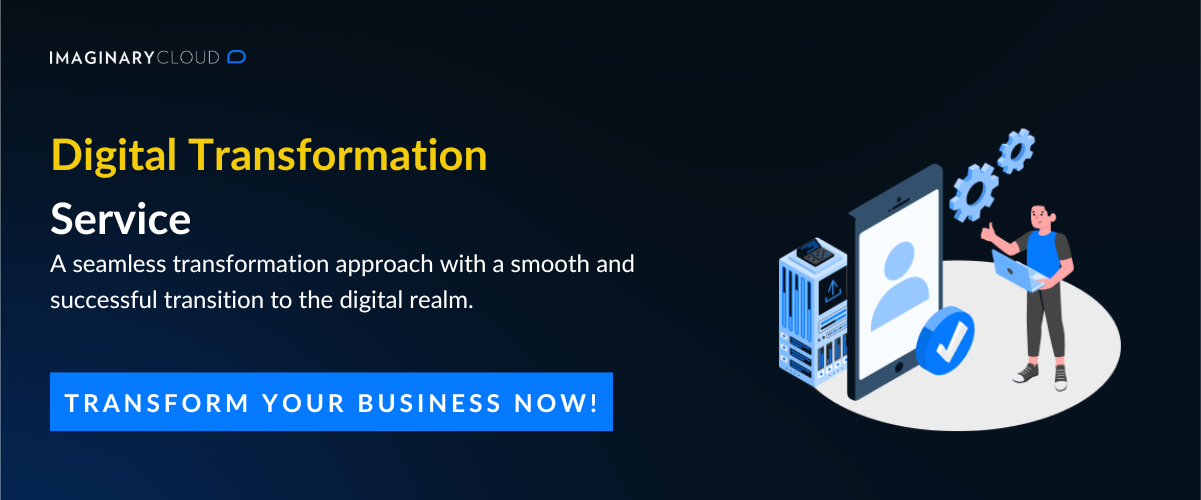Going through digital transformation implies keeping up and setting the pace in today's fast-changing business scene. It unlocks the potential to improve efficiency and customer experiences for your organisation. But what does this journey entail? From AI to the seamless connections of IoT, digital transformation is all about leveraging tech to propel your business forward.
How can these technologies help your business, and where do you start? That's what we'll explain. We'll discuss the top digital transformation technologies and their real-world effects to inspire you to innovate. Ready to dive? Let's get to the heart of transforming your business for the digital age, one tech breakthrough at a time.
Table of Contents
Digital Transformation Types
Top Technologies in Digital Transformation
Business Impact of Digital Transformation Technologies
Implementing Digital Transformation
Conclusion
Digital Transformation Types
Digital transformation reshapes businesses using many methodologies, each focusing on a particular aspect of the company. Understanding these categories is critical for properly using digital technology to drive growth and innovation.
Business Model Transformation
This type of transformation reimagines the foundational aspects of how a company delivers value to its customers. It involves rethinking products, services, and revenue streams in the context of digital possibilities.
Companies might shift from selling physical products to offering them as a service (PaaS) leveraging digital platforms. Businesses adopting digital business models see an increase in revenue growth compared to their peers. This transformation requires technological adoption and a strategic overhaul of the business's core operations and value propositions.
Process Transformation
Process transformation is concerned with optimising or reengineering internal processes using digital technology to improve efficiency, save costs, and improve agility. Examples include using AI and ML to automate repetitive tasks, IoT to streamline supply chains, and cloud computing to improve data management.
Success in this field demands a precise combination of technology, people, and procedures, with digital solutions complementing rather than replacing human expertise.
Organisational Transformation
This transformation type addresses the company culture, structure, and workforce capabilities to support digital initiatives. It's about creating an environment where digital-first is the norm and innovation thrives. Key elements include:
- Fostering a culture of continuous learning.
- Promoting cross-functional collaboration.
- Developing digital literacy across the organisation.
Companies with solid innovation cultures are much more likely to succeed in digital transformations, highlighting the critical role of people and culture in digital success.
Domain Transformation
Domain transformation refers to entering new markets or creating new industries by leveraging digital technologies.
It's the most ambitious type of digital transformation, requiring visionary leadership and a willingness to take calculated risks. Examples include traditional retailers creating online marketplaces or automotive companies venturing into mobility-as-a-service.
Top Technologies in Digital Transformation
These technologies are the pillars of digital transformation, offering businesses the tools to innovate, compete, and thrive in a digital-first world. However, adopting these technologies comes with challenges, such as the need for skilled professionals, concerns over data privacy, and the potential for an increased digital divide.
Let's explore the core technologies fueling digital transformation and how they reshape the business landscape.
Artificial Intelligence (AI) and Machine Learning (ML)
AI and ML revolutionise how businesses analyse data, automate processes, and engage with customers. They're at the heart of predictive analytics, natural language processing, and robotic process automation (RPA), enabling smarter decision-making and efficiency improvements.
For example, AI can optimise supply chains by predicting inventory needs. At the same time, ML algorithms can tailor marketing messages to individual consumer behaviours, significantly enhancing personalisation and customer satisfaction. According to a Goldman Sachs senior strategist, businesses that fully integrate AI will boost corporate profits by 30% or more over the next decade.
Challenges: Integrating AI and ML requires significant data infrastructure and expertise. There's also the ethical consideration of how these technologies impact employment and privacy.
Unleash the potential of AI and Data Science for your business. Explore Imaginary Cloud's cutting-edge solutions and transform your data into success!
Blockchain Technology
Blockchain's most notable feature is its ability to create secure, transparent, and immutable records of transactions.
This technology is transforming sectors by enabling smart contracts in real estate, enhancing traceability in supply chains, and securing patient data in healthcare. Its decentralised nature reduces the reliance on intermediaries, potentially lowering costs and increasing efficiency.
Challenges: Adoption hurdles include the complexity of blockchain technology, scalability issues, and regulatory uncertainties, especially in sectors like finance.
Internet of Things (IoT)
IoT connects devices across the internet, allowing for the seamless exchange and collection of data.
IoT sensors can monitor equipment health in manufacturing in real time, preventing downtime through predictive maintenance. Smart cities leverage IoT to enhance public services, from optimising traffic flow to improving energy efficiency. In agriculture, IoT devices monitor soil moisture and crop health, supporting precision farming practices.
Challenges: IoT implementation faces challenges related to data security, privacy concerns, and the need for substantial investment in infrastructure.
Augmented Reality (AR) and Virtual Reality (VR)
AR and VR offer immersive experiences that can transform education, entertainment, retail, and more. AR overlays digital information onto the physical world, enhancing real-world interactions with virtual elements. VR creates entirely virtual environments, offering profound implications for training simulations, therapeutic applications, and immersive gaming.
Retailers use AR to let customers visualise products in their homes before purchasing. At the same time, VR is revolutionising skills training, from surgery to machinery operation.
Challenges: Barriers include the high cost of AR and VR development and the need for user adoption of specialised hardware, although these are gradually decreasing with technological advancements.
Cloud Computing
Cloud computing provides scalable and flexible resources over the internet, from storage solutions to computing power and sophisticated analytics tools. It supports remote work environments, facilitates disaster recovery, and enables businesses to experiment with new applications without heavy upfront investments.
Cloud services are foundational for startups and established companies, enabling rapid scaling and global expansion.
Challenges: Moving to the cloud requires careful planning around data migration, security, and compliance, especially for industries with stringent regulatory requirements.
Cybersecurity Measures
Cybersecurity is important in an era where digital assets are as valuable as physical ones. Digital transformation has increased cyber threats, making robust cybersecurity measures essential.
Cybersecurity Ventures predicts that cybercrime costs will reach $10.5 trillion annually by 2025, highlighting the importance of investing in security to safeguard digital and physical assets.

Business Impact of Digital Transformation Technologies
Adopting digital transformation technologies is not just a trend, it's a fundamental shift in how businesses operate and create value. Let's dive into these technologies' tangible impacts on various business aspects.
Operational Efficiency
Digital transformation streamlines operations, significantly reducing costs and improving efficiency. For instance, implementing AI for predictive maintenance can decrease downtime and increase machinery life. Moreover, cloud computing allows for a scalable infrastructure that adapts to demand without significant capital expenditure.
Customer Experience
In the digital age, customer expectations are higher than ever. Technologies like AI and IoT provide businesses with the tools to offer personalised experiences, enhancing customer satisfaction and loyalty. Retailers using AI for personalised recommendations might see a sales uplift of up to 15%, suggesting that personalisation is key to winning customers' hearts and wallets.
Innovation and Product Development
Digital technologies enable rapid prototyping, testing, and deployment of new products, significantly reducing time to market. For example, using cloud-based platforms for development can shorten product development cycles by 30%, allowing businesses to respond quickly to market changes and customer needs.
Market Competitiveness
Digital transformation is not optional for businesses seeking to remain competitive. Companies needing to be faster to adopt new technologies must catch up as digital-savvy competitors leverage tech advancements to capture market share and drive growth.
Data-Driven Decision Making
Collecting, analysing, and acting on data is one of the most significant benefits of digital transformation. Organisations that harness the power of big data analytics for decision-making could improve their productivity and profitability, highlighting the critical role of data in driving business success.
Implementing Digital Transformation
Embarking on a digital transformation journey is a monumental task that requires careful planning, strategic insight, and a keen understanding of the challenges and opportunities. Below, we explore the essential strategies for successful digital transformation and address the common hurdles businesses may encounter.
Strategies for Success
-
Leadership Commitment and Vision: Successful digital transformation starts at the top. Leaders must be fully committed, setting a clear vision and fostering a culture that embraces change.
-
Customer-Centric Approach: At the heart of digital transformation is enhancing customer experiences. Businesses should leverage technologies like AI and analytics to gain insights into customer preferences and behaviours, aiming to tailor experiences that meet or exceed expectations.
-
Agile and Scalable Infrastructure: Embracing an agile methodology and scalable cloud infrastructure can accelerate innovation and adaptability. Companies that adopt agile practices can improve their project success rates by 64%, illustrating the value of flexibility in the digital age.
-
Investment in Talent and Skills: As new technologies emerge, the demand for digital skills skyrockets. Investing in training and development is crucial. Organisations focusing on upskilling their workforce can see productivity gains, emphasising the importance of human capital in digital transformation.
-
Data Governance and Cybersecurity: With the increasing reliance on data, establishing robust governance and cybersecurity measures is non-negotiable. A comprehensive security strategy can reduce the risk of data breaches, highlighting the financial and reputational stakes involved.
Overcoming Challenges
-
Resistance to Change: Change management is a critical component of digital transformation. Overcoming resistance requires clear communication, involvement of all stakeholders in the process, and demonstration of the tangible benefits of digital initiatives.
-
Integration with Legacy Systems: Many businesses struggle with integrating new technologies with existing legacy systems. A strategic approach involves assessing which legacy systems can be retained, upgraded, or need replacement, balancing innovation with practicality.
-
Ensuring Data Privacy and Compliance: As businesses collect and analyse more data, they must navigate complex regulatory landscapes. Implementing privacy-by-design principles and staying abreast of regulatory changes are key to maintaining trust and compliance.
-
Bridging the Digital Divide: Digital transformation should be inclusive, ensuring access to technology and digital literacy across all segments of society. Businesses can play a role by partnering with educational institutions and community organisations to support digital skill development.
-
Sustainability and Ethical Considerations: The environmental impact of digital technologies, along with ethical concerns around AI and automation, are increasingly important. Companies are expected to adopt sustainable practices and ethical guidelines to ensure their digital transformation efforts contribute positively to society and the environment.
Conclusion
Digital technology can revolutionise business innovation, efficiency, and customer engagement. Our experience shows that AI, blockchain, IoT, cloud computing, and cybersecurity are essential for optimising operations, improving consumer experiences, and gaining a competitive edge. The journey of digital transformation, while challenging, is replete with opportunities for growth and innovation, demanding a strategic and adaptable approach from businesses.
Ready to take your business to the next level? Start your digital transformation today to unleash modern technologies' growth, innovation, and competitive edge. Contact Imaginary Cloud to explore how we can assist you in navigating digital transformation and achieving your company goals.



